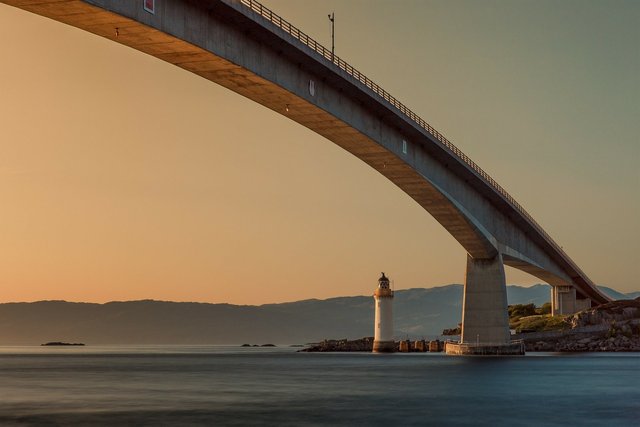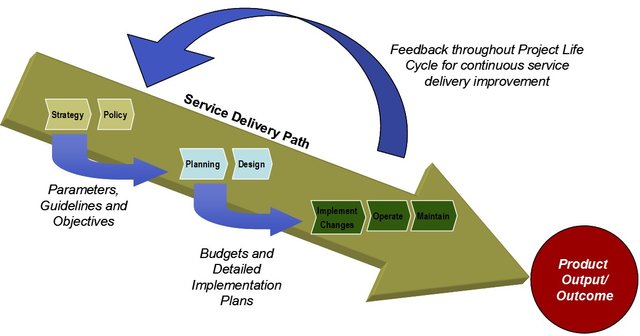African infrastructure - The Infrastructure Service Delivery Path (Part 3 in a series)
In this series on infrastructure in Africa, we'll follow up on my two previous posts (see list at the bottom of this post for links) by unpacking the "infrastructure service delivery path".

A virtuous circle
The infrastructure service delivery path starts with the basics - plan it, build it, operate it. An easy, virtuous circle, especially if you're an engineer. However, if you're a public servant responsible to a town, a city, a country, a group of countries or even a continent, you need to be thinking from the perspective of the people who will use the infrastructure.
Why do we need this infrastructure?
Is it to facilitate and enable investment? Trade? Commercial development? Environmental protection? Job creation? Economic growth?
This "why" question is the most important one in the infrastructure discussion, because it determines the purpose of the infrastructure and therefore the expected long term outcomes, results and impacts the infrastructure will have. It is important for planners and those responsible for public purses to reflect on the purpose of the infrastructure. This could well inform how it gets procured.
Let's take a ridiculous example, for the sake of discussion
For instance, let's take a totally fictional example of a bridge connecting an island with the mainland, and let's suspend disbelief long enough to suppose that the island has been really disconnected from the mainland, say, since the continents first started to move away from each other.
It would certainly change the islanders' lives, to have a bridge, wouldn't it? They'd be able to get their crops to mainland markets easier, they'd be able to access more potential customers, they'd be able to access cultural facilities and events, socialise with people on the mainland - all fantastic improvements to their socio-economic quality of life. The engineers and construction companies are thrilled at the idea, because they'd be able to design and build it.
But rats might get onto the island for the first time. Or feral cats, which would kill the birdlife and other small animals (okay, maybe they'd have a go at the rats). And perhaps the people would get access to rough bars and motorcycle gangs they'd never experienced before. It could really change the way of life on the island.
And what if the bridge is to facilitate a coltan mine on the island getting its product to market? (I doubt we'd find a coltan mine on an island, but just go with me on this.) Wouldn't it make sense to make it a toll bridge so those mining trucks pay for the bridge in some way, since they'd be profiting from the sale of their mineral?
That's not a real-life case study - it's just an imaginary example to show that it's important that those with the vision of "why" the infrastructure also consult properly on the range of potential impacts of the infrastructure being proposed.
Clearly, some conversation is needed
So - we think about the purpose of the infrastructure first, and how it fits into the local, provincial/state/national/regional/continental strategy first before we get hyper-enthusiastic and approve the expenditure of a couple of billion dollars we don't have on a 3 kilometre, six-lane highway bridge with an iconic design which will attract photographers from the world over.
What's it going to be?
Okay, we decided it's not going to be a vanity project, and we worked through our existing growth and development strategy, national development plan, or other overarching guide, to identify parameters, guidelines and objectives under the policy framework we've agreed as governing institutions.
The conceptual stage - who decides?

By this point we've also realised it's pretty important to get a lot more people involved in the discussion. Like, a LOT.
Here a just a few of the probably interested parties in this infrastructure initiative:
- the line ministry in government responsible for transport
- the finance ministry
- the health ministry (remember the rats)
- the social affairs ministry (remember the motorcycle gangs)
- organised labour
- civil society - local non-governmental organisations (NGOs), community based organisations, and perhaps international NGOs if there is some potentially threatened flora or fauna on that island
- local business associations
- the people on the island, and the people who are going to be trading more with the people from the island
So that group of four in the old ClipArt shot is going to grow to a much bigger constituency, and fast. The views of that constituency need to be channelled to a workable view on what can be achieved within those parameters, guidelines and objectives. And that is where leadership and strong institutions come to the fore. They funnel those views, desires, wants, visions and dreams into a workable set of practical inputs to the planning and design process.

Someone has to be accountable, in terms of the strategy and policies.
The planning stage, now that we've figured out - for now - who's accountable
So we know it's going to be a bridge. Will it be a highway bridge? Two lanes only? What do we know about the water body it's crossing? I hope for the sake of this example it's not like the sea next to the Alaskan town @johnnyray described in this post, where the tides vary 38 feet (that's 11.6m to most of the world ;-)) over 12 hours! That bridge would have to be pretty high so it doesn't get flooded.

Also, what kind of vehicles are going to cross it? How tough do we have to make the surface? Are there any local bridgebuilders in our town/state/country? Would we have to get foreign experts to come and design and build this bridge? Hey, wait a second, if we have to pay for foreign experts, that would mean we'd have to pay them in foreign currency, and...
...we've only got three months of foreign currency reserves in our central bank, we're indebted to our eyeballs to all of our International Cooperating Partners (ICPs - remember?), we're in regular discussion with the International Monetary Fund about a possible bailout, our fiscus gets only about 10% from tax payments, including income tax, value-added tax and corporate taxes and the rest comes from the generosity and concessional (low interest rate) loans of the international community.
So where are we going to get the money?
Let's go to the private sector!
That won't work, since the private sector is going to look at the country's ability to repay whatever loan it would make - and we've just gone through that.
So - where are we going to get the money?
The long and the short of it is - under those circumstances, we can't. But luckily, this is a fictional example, and it's also set a long time ago in a galaxy far, far away.
And now, to implement
You can see how quickly the question morphs from Why, to What, to How? Let's not forget the little Who, who is eventually going to use this bridge and probably end up paying for it somehow even if he doesn't know it.
This example would be really different at this stage if we were talking about getting water or electricity services to the house. The householder would be acutely aware of paying for the infrastructure service!
Sleeves up, some robust planning
We churn those parameters, guidelines and objectives around, consult with the planners and designers on what's possible for how much money, start talking with potential financial partners about who might be willing to foot how much of the construction costs. And the operation and maintenance costs. And who would do what of those activities, and how they would get paid. Would this be a chance to train up some local construction companies? Would it, as in Senegal in the mid-2000s when they were actively liberalising their electricity sector, be an opportunity to incentivise some local investors to become infrastructure owners and service providers?
History we don't want to go back to
Historically, nobody was willing to talk about who would foot the bill for infrastructure operation and maintenance costs. Donors would pay for "stuff" to get built (the kind you can cut ribbons for), and would leave all the less glamorous day to day running costs to the government. The money for that would come out of some mystery government support pot. But since it generally didn't, the regular monthly costs to clean the surface, paint the lines, repair the concrete and make sure the pilings were in good condition just didn't get paid. So the infrastructure crumbled.
That was then, this is now
African governments have come a long way since those early post-colonial days, and have built up much more sophisticated and effective capability to plan and manage their finances. Before you all jump on me, yes, there are 54 African countries and some do it (much) better than others.
So how do we frame this into a workable way of thinking?
Here's one way of encapsulating the infrastructure service delivery path.

Which helps us to consider....
Using this as a framework, we can start to take into account some more nuanced considerations.
Service levels
Take policies on service levels, for example. In electricity, this could mean, for instance - who gets a 3-phase, 60 ampere household connection? In water, who has to walk less than 500m to get water for the house? Who has an indoor toilet? Who gets a flush toilet? These are service level considerations.
Performance management
Who's responsible for managing the delivery of the infrastructure services, and checking that it meets standards? By the way, there was a raft of fascinating work done in crowded slums in the realm of community report cards. I can imagine how the blockchain could empower that kind of performance monitoring!
Good performance management would be rooted in a consumer focus and have clear lines of accountability.
Monitoring and evaluation would be done at each level - strategic, planning and operational.
And just to check that services are being delivered well, the infrastructure service delivery could be benchmarked to other similar operations elsewhere in the world. That's harder than it sounds.
Affordability
Infrastructure services simply have to be affordable over the long term not only to the consumer of the services, but also to the supplier. If the supplier, be it public or private, cannot afford to deliver the services, first to go is usually quality (in terms of parameters monitored by regulatory authorities) but fast on its heels is quantity (by that I mean availability to the consumer).
Conclusion
This is one way of looking at the infrastructure service delivery path to allow for the possibility of feedback. Feedback from consumers on the quality of service they are receiving, feedback from the entities responsible for running the facility on factors making it easier or harder to operate and maintain, feedback from regulators to policy-makers on improvements to policies, all leading back to the original conceptual phase which was based on certain assumptions and perspectives at the time...which may have changed dramatically in the interim. Think building standards before and after Hurricane Andrew and the 1985 Mexico City earthquake.
The one constant we see is that the context always changes.
Leadership and institutions cannot manage infrastructure service delivery in a static way. They have to approach it in a dynamic, systemic way which acknowledges the extraordinary innovations which we are seeing in our lifetimes.
The good looking images are from Pixabay, some are ClipArt from over a decade ago, and the rest I drew (badly) myself some years ago. Thank goodness for Pixabay.

Team South Africa banner designed by @bearone
https://steemit.com/africa/@kiligirl/african-infrastructure-development-a-nutcracker-suite-part-1-of-i-m-not-sure-how-many-yet
@kiligirl has got some magical powers to explain and convey her view point through some novel examples. :D Thoroughly enjoyed this style of writing.
Thumbs up brainy girl. Keep writing, supporting and rocking.
Steem On!
Thank you, @ugetfunded! It was actually quite difficult to think of an impossible example. I didn't want to get bogged down with arguments around specifics as I'm still in scene-setting mode. I'll get more factual as we start to drill into patterns of private sector investment and what encourages and discourages private companies from investing in infrastructure. As always, I really appreciate your support! Thanks for coming around! 😊😊
It's a pleasure @kiligirl.
😊😊
@kiligirl - Thanks for sharing a mind blowing Article, which is totally UNIQUE (Like its AUTHOR). In every past comment on your Posts, I always praised your job. But this one is something EXCEPTIONAL. Something OUT OF THE BOX. I can't believe that We have still such great people in our lives who think about HUMANITY and always produce quality work. I'm in Love with your Positive thoughts towards community, your way of writing and overall Presentation. You must be included in TOP 10 Writers of the world. Please continue creating great ideas for this awesome community. Stay Blessed!
Wow, @jawad09, I was just saying to my partner that I thought this was my worst post so far, that I hadn't communicated the essence of what I was trying to communicate. You've REALLY lifted my spirits. Thank you so much!😊😊
I just know this is all "going somewhere" @kiligirl; and when you get there, I'm equally certain the journey will continue! In the short term, I'm looking forward to the instalment on "financing"!! My guess is that's when / where "Superkiligirl" will re-surface!!
A bridge connecting an island can bring what type of changes is known to me as the longest bridge of Asia is in our country which was inaugurated a few months back. This island is famous for production of ginger. Now,these people have got a proper market to sell their products at very less transportation cost. Lots of changes has come in these areas..
Upvoted and resteemed..
Seems like a sound, useful idea. It seems the islanders' lives would get a 'boost' - I mean they'd be able to get #Supplies more easily, and attend events - whether educational or #entertainment, I'm sure the people would appreciate.
I agree with the idea that Mining trucks (as in yr Example) ought to 'chip in' as they'd be profitting. (from 2nd paragraph).
the impacts should be weighed & considered beforehand - yet I also like your idea of #Feedback from consumers on the quality of service they're getting (as time goes along), and Feedback from policymakers & regulators.. as well as feedback fm those who run the facility .
Suggestions, as things move along, should be welcome. Yet at times, people can be SHY about speaking up; so if there's a discussion with a whole lot of people maybe there should be a silent vote (in response to different Questions as to how beneficial the bridge is, whether such-and-such is a problem/issue, and How things/systems might be improved).
And ALWAYS with the original purpose at the Forefront of everyone's minds . This would be necessary, so there wouldn't/couldn't be mindless wandering & (i.e, wasteful) discussions that use up time.
I Love South Africa Country and good my friend💙💙
But wait, have you been to Africa before?
Fun fact, since I see you're from Nigeria: I did 9/11 in Lagos. Was part of the team doing the initial restructuring of the electricity distributors for private sector participation, and our SAA flight was supposed to originate from JFK around 9:30 that morning, which it didn't...so the airline put me, my colleagues and a few others from our flight up at a place called the "Marriott" Hotel. I say "Marriott" in quotes, because it wasn't really a hotel, more like a converted residence. That was in the days when we still used landlines to communicate across the continent!
Wow, you're definitely a tourist. It must have really been a nice time for you. I'm glad to have seen your post.
How do you define tourist?
A person who travels to a place for pleasure or culture.
Then I've been a terrible tourist over the years unless we can agree that work can bring much pleasure and teach much about culture.🙃 I've been privileged to develop lasting friendships in the countries I've worked in, and I treasure those. 😊😊
That's really great. I wish I could tour Africa the way you did or even the World in general. But some factors would certainly influence that.
Yes...first time in 1989...back and forth between Canada and Southern Africa from then until 1997 when I moved to South Africa (where I've lived ever since)...have worked in >30 African countries 😊😊
a very good post thanks for sharing stories, success is always friends! I want to like you post. but not yet. guide this friend From @all-aceh. take a moment to see my post!
https://steemit.com/food/@all-aceh/cake-yellow-egg-make-a-sponge-cake
Upvote from:
@originalworks
@kiligirl
The @OriginalWorks bot has determined this post by @kiligirl to be original material and upvoted it!
To call @OriginalWorks, simply reply to any post with @originalworks or !originalworks in your message!
To enter this post into the daily RESTEEM contest, upvote this comment! The user with the most upvotes on their @OriginalWorks comment will win!
For more information, Click Here! || Click here to participate in the @OriginalWorks writing contest!
Special thanks to @reggaemuffin for being a supporter! Vote him as a witness to help make Steemit a better place!
Congratulations @kiligirl, this post is the tenth most rewarded post (based on pending payouts) in the last 12 hours written by a Hero account holder (accounts that hold between 10 and 100 Mega Vests). The total number of posts by Hero account holders during this period was 254 and the total pending payments to posts in this category was $3933.15. To see the full list of highest paid posts across all accounts categories, click here.
If you do not wish to receive these messages in future, please reply stop to this comment.
My Dearest Friend Kiligirl, I hasten to comment regarding your last 3 posts. It shames me to tell you that there is so much of your concepts here that just allude me. The second 2 posts, along with your examples, are helping me to make the leap, but this is probably something Ms. Jane is really good at understanding. In support of your effort, I resteemed a post that sounds a little like what you are trying to achieve but from a different angle.
I am so sorry because this is your realm of expertise! I would like to understand. You did a real nice drawing of the stairwell and the bridge. Maybe next time you should use stick figures and I will get it. Much Love from Ellie Mae. 🐓🐓
Hi, Ellie Mae, I'm trying really hard to demystify this for people not in the infrastructure business - because frankly, we're all in the infrastructure business as customers in some way, shape or form, and it's useful to understand what sits behind the stuff we can see. Please ask any questions you have in any way to help me understand what the difficult bits are.
I saw the post you resteemed - it was excellent! I told the author in a comment it was you who pointed me there :-).
Thanks for the really nice compliments on my drawing - that's the stuff that comes from Pixabay. The doofus looking stuff is what I put together myself. I can just about handle drawing stick figures, so maybe I should start there!
Much love back - LD 😘😘
Dear Friend Kiligirl, after reading part 3 for the 3rd time I am beginning to understand.
Here are my questions:
As long as you find a funding source, and you train local people to complete differing parts of the project you are coordinating, why not make the same system available to every home?
I am talking about water and sewage here. That way the initial pipeline is already laid. If the consumer cannot afford that luxury, then perhaps it is not fully implemented yet. Better yet remember pay toiletets at the road stops many years ago?
This is a frustration we continue to have with services from AT&T . Who gets what service and how fast. The lines are laid but clearly rural isn't populated enough to turn on the fast speeds.
I really like the idea of having local people trained to implement services. Provides income and a teachable moment.
If there are parts of a community that are really poor, that you want to provide services to..... why not creat an outpost? A local library if you will or maybe a truck stop . Showers, wifi, water machines, books, bicycles, even simple groceries, available at one central location.
This is what I was wishing was available during Irma.
I hope you can see that you are making progress with me. Just looking at it from a consumers point of view.
Once people see the possibilities then they may be incentivized to find a way to have these luxuries in their own homes.
Which leads me to another question. Which I will ask you later on.
I knew those pics were from pixabay. I just had to give you a hard time. I can sense your frustration with me. It is starting to seep in. I just have to rearrange my brain a little and try to understand a bigger picture.
Love you much your friend Ellie Mae🐓🐓